Posts Tagged ‘Simeon Cortezano’
This week in Magic: Making Day 2 of GP Boston-Worcester
Thursday, July 31st, 2014
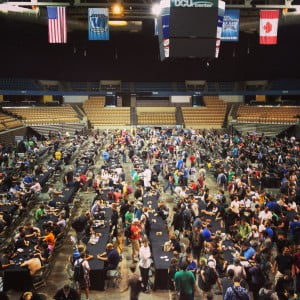
This past weekend was definitely a good weekend for me. In case you missed it, I made Day 2 of GP Boston-Worcester. It was so much of a surprise to myself that I was not at all prepared. I was such a mess that day, I didn’t even have a belt, and my pants were falling all day. Long story-short, I am in the middle of a move and my belt is in storage.
Not only was I missing a belt, but when I made Day 2 I was in scramble mode to find a place to sleep since my buddy Josh didn’t make it and wasn’t planning on driving into Worcester from the South Shore again. I was lucky enough to have a couple of offers to crash on the floor of friends’ hotel rooms. (Thanks to both Carl and Jason, by the way).
It should be no surprise what I played at the GP. If you’ve been following me for a while now, you’d know that I played Mono Red Burn. I went 7-2 on Day One, and unfortunately finished 2-3 on Day Two. While I missed out on cashing, I was just happy to make Day Two, as well as many of my other friends.
The journey to this point was not easy. I did a fair share of testing, and while testing, I got my fair share of stares and losses. There were times I felt defeated playing this deck. Day Two was never in my sights. I didn’t even pack a bag. Still, I managed to persevere. For your enjoyment, here is the list I ran:
Mono Red Burn aka 20 Mountains
Main Board:
4x Goblin Guide
4x Hellspark Elemental
4x Eidolon of the Great Revel
4x Lightning Bolt
4x Lava Spike
4x Shard Volley
4x Searing Blaze
4x Rift Bolt
4x Skull Crack
4x Flames of the Blood Hand
20x Mountain
Side Board:
3x Combust
2x Relic of Progenitus
2x Anger of the Gods
2x Molten Rain
3x Shattering Spree
3x Searing Blood
Hellspark Elemental was a last minute change over Spark Elemental. After some playtesting with my friend Jay, I had come to the conclusion that Spark Elemental was missing something. That something was being able to use itself over again. Hellspark Elemental’s ability to Unearth itself is huge. You’re essentially running eight of them.
I came across a nice variety of decks at the GP. In fact, during Day One, I played against two 8Rack decks. My two losses came against Merfolk and Fairies. I’ve never had a good run against Fairies, even when the deck was in Standard. I also did not test against it much outside of the tournament. My wins came against Jund, 2x 8Rack, 2x Scapeshift, GB, and UR Twin. Aside from the Twin match, the other decks were great opponents for me. As for my Twin matchup, he got land screwed game one, and then I just out burned him game two. He was gracious in his loss, and wished me luck after the match.
I should add that my two losses were within the first four rounds of the day. Thus, I had to win out the entire day. I definitely felt the heart palpitations coming on near the end of the final match. It went to third game, and thankfully I won it.
Day 2 was a little rough for me. Round one had me against my worst matchup in round one, Ad Nauseum. My only two wins came from another 8Rack match and a Jund match. The losses came from Ad Nauseum, Affinity (which was a heartbreaker for me), and Twin. Those last two losses were very close. Both my opponents let out big sighs of relief. Although, I’m not sure if it was because the matches were close, or they didn’t want to lose to Mono Red Burn. It could have been a combination of both.
Overall, I had a good time at the event. I mean, if you make Day 2, then there isn’t much to complain. Especially if you’ve never done it before. Sadly, I have been sick the past several years that a GP has been in the area – whether it was in Massachusetts or in Rhode Island. One year I made showed up on the second day of GP Boston the last time it was held in the Hynes Convention Center. However, I was so sick that day, I don’t remember much of it.
There were some things to be said about the GP on a finer level, but I’ll save that for another time.
Making changes to the deck
You already know I changed my Spark Elementals to Hellspark Elementals. There is very little I would change in the deck. If you’re looking for a very budget deck to run in Modern that has a good shot of winning a small sized tournament, this is your deck. If I were to run it in another major tournament, maybe something that is coming up in a couple of weeks, I would definitely throw in fetch lands. I would need to do more testing before I suggest running four or eight fetch lands, but, either way, they need to be run. The main reason: Searing Blaze.
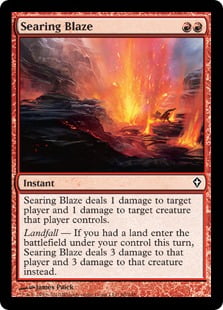
This card can really make or break the deck. Alone, it can be both the best card in the deck and it can be the absolute worse thing ever. It all depends on the landfall trigger. Even then, you can only cast this card on your turn. Thus, you’re never able to take full advantage of the spell. I’m sure if I had fetchlands in this deck, it would have run a lot more efficiently. I would have been able to thin the deck out and almost guaranteed I would have a way to trigger landfall.
In the end, the call is yours. Just remember it can mean the difference between a $50 deck and a $410 deck.
About the author
Simeon is now the Community Manager for Battleground Games & Hobbies. If you have any questions or inquiries, then you can reach him at Sims@battlegroundgames.com. He is also an avid gamer who loves to play board games and video games. He graduated college with a degree in Political Science, and now serves the public by writing about games. You can check that out here. Don’t forget to “like” him on Facebook as well. It’ll update you on all of his newest content. Best of all, you can follow Simeon on Twitter (@SimeonCortezano) for some real time hilarity. Thanks for reading!
Donate to the Extra-Life fundraiser!

Join the Battleground Games & Hobbies community forums!
Please don’t forget to check us out on Facebook and follow us on Twitter @battleground_gh!
Tags: gp boston-worcester, Magic the Gathering, Modern, MTG, Simeon Cortezano, Wizards of the Coast
Posted in Blog, Card Games, Events, Featured Author, Featured Post, Magic: The Gathering, Popular Posts | 3 Comments »
This week in Magic: A Modern Primer
Thursday, July 24th, 2014
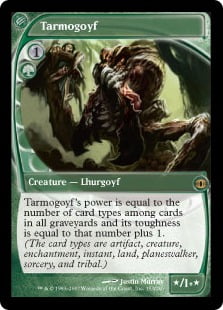
Is it still Grand Prix Boston or is it Grand Prix Worcester? Even worse, do we call it Grand Prix Boston/Worcester? Actually, according to the official site of “Magic: The Gathering,” they have it listed as Grand Prix Boston-Worcester. Well, however you see it, the Grand Prix is finally here. Are you ready for it?
I’m as ready as I have ever been for a tournament. Never have I ever prepared this much for any kind of tournament. I have the attention span of bubble gum. For me to stick with a deck this long is unheard of. There is, of course, plenty of time for me to call an audible and switch decks the night before.
If all goes as planned, I will be running Mono Red Burn. This is slightly different from Red Deck Wins as this deck runs fewer creatures and a heavier burn package. This also should not come as a surprise as I have been writing about the deck for the past several weeks. Note: I do plan on finishing that series. I’ll most likely do it once the GP ends and will have final thoughts about it.
What about you? What are you planning on running? Don’t worry; there really is no wrong answer to that question. Here is a quick breakdown among the three different types of meta: Combo (37%), Control (27%), and Aggro (36%). Now that we know this info, let’s break things down even more. We’ll go a little more in-depth with each meta and look at the different decks that are the most popular within their meta.
Aggro
To no one’s surprise the top dog here is Affinity. This deck is so good and very fast. When you’re on the other side of things, there is no greater fear than watching your opponent drop their hand on the first turn of the game. Who knew that something like Signal Pest, such a small and very un-intimidating creature, can be so deadly? When he’s teamed up with his buddies Memnite and Ornithopter (even Inkmoth Nexus) things can quickly get out of hand. Knowing your opponent is playing Affinity is not always the end of all things. I’ve seen plenty of these decks sputter out and run out of gas. Keep your head cool and things will be okay.
Next up is Jund. This is one of those decks that took every powerful card in the format and smooshed them all together. Take a look at its creature package for example: 4x Tarmogoyf, 4x Dark Confidant, 3x Scavenging Ooze, and 3x Courser of Kruphix. A very strong creature package teamed with a very disruptive spell package, and you have the makings of the one of the best Aggro decks in the format. Thoughtseize, Inquisition, and Liliana are the best in the game. Get ready for a fight and have a well prepared backup plan ready when these are pointed at you.
I played against a UR Aggro deck at a recent GPT. I remember staring down a Young Pyromancer on turn two and had the choice of burning my opponent or killing the creature. It was early on in my Mono Red Burn experience, so I opted to burn my opponent in the face. I can definitely tell you that I paid for that mistake in full. The next time around, I did not hesitate to burn it and I went on to win the match. This deck is just a conglomerate of Delvers and a spell package tune for tempo. Don’t let this deck’s appearance fool you. It packs a solid punch.
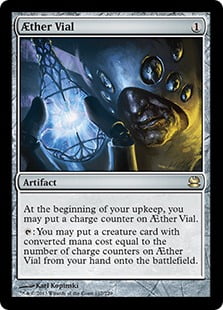
Merfolk rounds out the top five decks in the Aggro meta. This deck takes full advantage of the Aether Vial and shows why this card is so powerful, no matter what format it’s in. You need to take these fish seriously. In it’s entire creature package, half of them are lords. Each one pumping the other up. Add Aether Vial into the mix and you have a recipe for destruction. One thing to keep in mind, though, is that while the Merfolk player is playing islands, they don’t play many counterspells. Don’t be afraid to run a spell or two out out there.
Control
I’ve always been a big fan of Tron decks. Therefore, to see this as top deck in the Control meta makes me very happy. Playing with the Urza Tron lands almost feels like cheating in a way, but you’re not. Being able to produce seven mana on turn three allows the player to do many silly things. One of those things is being able to cast Karn Liberated. At first glance, sure, he’s a pretty powerful planeswalker, but on turn three it’s not fair. After his first positive activation, he sits there at ten loyalty and almost impossible to kill with creatures. Even worse, he exiles permanents getting around any kind of indestructibility they might have. If you let things get too far, he just resets the game.
Tron decks have numerous ways to have fun besides Karn. If they need to they can play Wurmcoil Engines and even CAST Emrakul, the Aeons Torn.
In the recent weeks, I’ve seen GB Rock decks pick up in popularity. With their package of hand disruption, I’m not surprised, especially since Twin is one of the most popular decks in the format. I know what you’re saying, though. “Jund runs a similar package.” Yes, but now we’re dealing with two colors. In a format where mana can be a serious issue, having stability can be more appealing than added aggressiveness. Obstinate Baloth is a nice touch. Not only is it great against Mono Red decks, but it helps Rock players with sustainability, and Liliana is a real threat. Imagine discarding a Baloth to a Liliana? Ouch.
I’m going to put UW and UWx Midrange decks together. This color combination will always be a very popular choice. The strat is a little simple: control the game until late, then let your man-lands take over. It takes a special person to pilot control these kinds of decks. However, once mastered these decks can prove to be very powerful. With the splash of Red, the player gains access to spells like Lightning Bolt, Electrolyze, and an endless amount of ammo for your side board. The obvious difference between the decks is how aggressive the UWx Midrange decks can be. In the end, it really comes down to your play style.
Combo
This meta has some of the most powerful and popular decks in the format. However, while it may be difficult, they are not unbeatable. First up is Birthing Pod. This deck was a house in Standard. With an expanded line-up, there isn’t any surprise that it’s, once again, running the show. Although, from what I’ve heard, there hasn’t been much spotted in the Massachusetts area – at least in the South Shore. This is one of those tool box decks that plays numerous one-ofs. These “one-ofs” are enough to win a person the game and match. The creature package from casting cost one through three are almost the same every time: Birds, Voice, Finks, and and Hierarch. Getting a Pod out as fast as you can is key and once it’s out, things can start to turn in favor of whoever played it first.
One of the most popular versions was the Melira Pod combo. This aimed to get a creature like Viscera Seer out with Melira, then continuously sacrifice Kitchen Finks to scry through your entire deck and gain millions of life. Another cute combination I came across, recently, was the interaction between Archangel of Thune and Spike Feeder. I was lucky enough to stop this frightening combo, but I emptied my hand in the process. It was worth it. There are even version of Pod that play Kiki-Jiki. This has the same premise as the Twin Control decks, but uses a Birthing Pod to get the tools into play.
Speaking of Twin, this is one of the most popular decks I have seen in the area. Again, there are a couple of versions people like to play. There is the regular Twin Exach combo deck and then there is Tarmo-Twin. The regular version of the deck plays a strong control game, while it try to get it’s combo pieces. You know your opponent is trying to go off if they play either a Deceiver Exarch or Pestermite at the end of your turn. This tends to lead into a Splinter Twin being played the following turn. The Tarmo-Twin decks play (if you couldn’t tell already) Tarmogoyfs as an alternative win condition. At first sight it seems a little weird, but this just proves how powerful this little guy is. Having trouble with a deck your playing? Play four Tarmogoyfs and all your troubles will go away – even if you’re not playing Green; force it in there.
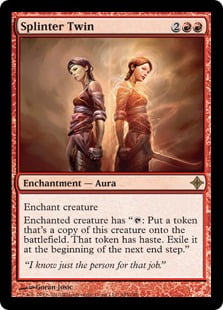
So how does it work, really? Well, once your opponent has either a Pestermite or Deceiver Exarch in play, they will cast a Splinter Twin onto it. The aura gives the creature the ability to tap itself and put a copy of itself into play with haste. The neat trick here is that when either of these creatures comes into play, they can untap a permanent they control. Can you guess what get’s untapped? That’s right, the original creature with the Splinter Twin attached to it. The player goes on to make enough copies to get through your defenses and kills you via a swarm of creatures.
Scapeshift is another very popular Combo deck in the area. There is a little bit of math involved here, but if you understand the timing (and the person who plays this deck will, most certainly) then you can control one of the most devastating decks in the format. Scapeshift is a sorcery speed spell that allows the caster to sacrifice any number of lands. They then search their library for that many lands and put them into play. Sounds boring, right? Well you’re partially correct. The key card they have to get is Valakut, the Molten Pinnacle. Without this card, the deck plays a lot of lands (specifically mountains) for nothing. Be a little cautious though, Scapeshift sometimes packs a small package of counterspells. I learned the hard way that this deck can have up to four Izzet Charms. This is bad when you’re a Mono Red Burn player.
The last of the Combo decks are Infect, Living End, and Storm. Infect is one of those decks that you know right away if you’re playing. You don’t know how many times I’ve heard people groan at the turn one Glistener Elf. It could potentially kill you on turn two. As long as you keep it off of anything it can pump up, then you should be okay. Living End is one of those decks that can just show up and win a tournament. A big reason is because no one knows how to play against it. For some, the Cascade mechanic is still a bit of a mystery to them. Just remember this, you can still counter a spell that is being cast via Cascade.
Finally, Storm reminds me a little like Scapeshift. Although, I guess the same could be said for any combo deck. Basically, I’ve seen plenty of Storm decks fizzle while attempting to combo off. As a Mono Red Burn player, I hope to cast an Eidolon of The Great Revel before they go crazy. However, if you’re not in my position, then hope to kill them before they kill you. Thanks to the ridiculousness in high variance for these decks, not many people choose to run them.
Well, that’s it for now. I really hope you enjoyed this “small” primer of what to expect this weekend at the GP. The Modern Format is such an open format, though. I remember someone mentioning to me that it all depends on what the flavor of the week is. Considering how many decks do well time and time again, that person may have a valid point. Remember to get plenty of sleep and, most importantly, try to have fun. I’ve missed these big events the past three years due to either illness or something else. I’m going to do my best to have as much fun as possible.
PS. Don’t forget to say hello if you see me this weekend. Let’s take some photos together!
About the author
Simeon is now the Community Manager for Battleground Games & Hobbies. If you have any questions or inquiries, then you can reach him at Sims@battlegroundgames.com. He is also an avid gamer who loves to play board games and video games. He graduated college with a degree in Political Science, and now serves the public by writing about games. You can check that out here. Don’t forget to “like” him on Facebook as well. It’ll update you on all of his newest content. Best of all, you can follow Simeon on Twitter (@SimeonCortezano) for some real time hilarity. Thanks for reading!
Donate to the Extra-Life fundraiser!

Join the Battleground Games & Hobbies community forums!
Please don’t forget to check us out on Facebook and follow us on Twitter @battleground_gh!
Tags: gp boston, Magic the Gathering, Modern, MTG, Simeon Cortezano, Wizards of the Coast
Posted in Blog, Card Games, Featured Author, Featured Post, Magic: The Gathering, Popular Posts | 1 Comment »
This week in Magic: Fat challenges, fat packs
Thursday, July 17th, 2014
This has been one of the craziest weeks of my life. If all goes right, hopefully it will get even crazier with the Fat Pack Challenge that is coming up this Friday. How many of you have been to the Fat Pack Challenge before? Okay. Well you’re in or treat. As the name implies, instead of having the usual six packs for a sealed event, we’re using Fat Packs – which have nine packs.
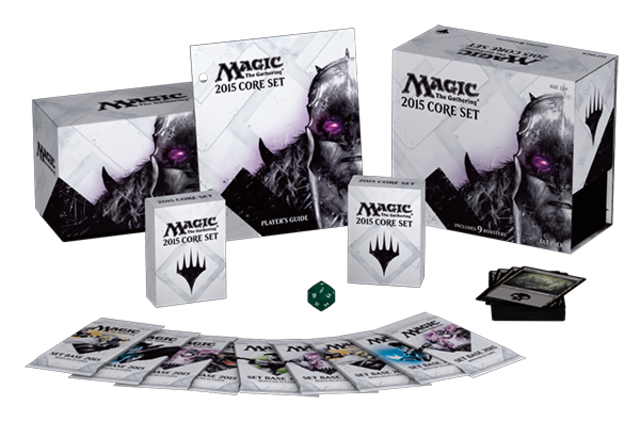
You would think that there would be little difference between six packs and nine packs. However, this is a huge difference. It is makes for quite the challenge. Hence : “Fat Pack Challenge.” More options basically mean more decisions to make. If you asked me which would I prefer? It’s really nice having to make decisions than no decisions.
When I last talked about the Fat Pack Challenge, it was for Journey Into Nyx. That was an interesting Challenge. The biggest reason was due to the potential to open up a God Pack. Unfortunately, no one at either event (Abingtong & Plainville) opened one (at least to my knowledge). In this round of the Challenge, there are no God Packs. Still, Magic 2015 has shown itself to be a really fun set.
Ornithopter – really?
From what I had read along the Twitterverse, Ornithopter was in a lot of main decks over the weekend at pre-release events. Just check out this dicussion thread started by Marhsall Sutcliff and replied by Owen Turtenwald:
https://twitter.com/OwenTweetenwald/status/488191104274034688
Who would have thought that this little guy would be such an all star? From being an easy sac target for Shrapnel Blast to being one of the many creatures to cast spells with Convoke, Ornithopter seemed to do it all. I mean, to think about it, I wouldn’t even want to bother killing it. I guess that’s why it’s such a threat.
However, based off of some of the reactions by the professional players, while it may have been a surprise that many people were playing it main board, they still thought it was not even worthy of coming in from the side board. This is definitely something to think about.
How do you feel about it? Would you play it for some cheap effects? Let me know. I’m quite curious to know.
17 lands or 18 lands?
I’ve always been accustomed to playing 17 lands in Limited. I think that playing 18 is something situational, and only if you’re playing into a heavy curve. In a recent article, Travis Woo discussed this very issue. According to Travis, he states that playing 17 land is more situational and something you do if you play ramp spells. By playing 18 lands, you help yourself by lowering the chances of getting mana boned, and you increase your chances of being able to play that high CC bomb you’re looking to drop on your opponent.
Why do I play 17 lands? I guess the question should be more like, “When should I play 17 lands?” For starters, if you have a small mana curve, then it would make total sense to play 17 lands. In a deck where your highest casting cost spell is four mana, the last thing you want to happen is to get land flooded. Just keep in mind, sometimes it’s better to play a little loose and safe rather than tight and dangerous.
More possible strategies
Some of these strats may be basic to some of you, but the Fat Pack Challenge tends to bring out new players. For them, this is the first time in a sealed event. So, here are some tips from the Zen Master of Sealed: me (Ken Briscoe can testify to this).
When making your deck, try to stick to one or two colors. As you get into three or four color territory, the potential to miss your colors goes up. What can be done to remedy this? One thing that can be done is mana fixing. Luckily in M15, we have the benefits of the Pain Lands making their return to Standard. While you only get two colors out of them, producing a 2-for-1 is still nice. Thanks to spells like Nissa’s Expedition and Verdant Haven, mana fixing becomes a little bit easier as well, so long as you’re playing Green.
Stick to 40 cards. Don’t go 41, 42, or 43. Now I’m sure you’re asking why. The main reason is to be able to draw the spells you want. There is a great article from Jeff Cunningham (circa 2006 via the Mothersite) that explains this well. Playing 40 cards allows for a more focused strategy. Typically when you play more than 40 cards, it can end up diluting your deck and your draws. When you draw a spell from your deck, you want that card to make an impact and not linger around. In some cases, by the time that particular card’s moment to shine comes, it may be too late for you.
Some final thoughts
The most important thing to remember at these events is to have fun. These strategies I proposed at just that – proposals. You don’t have to follow mine, or anyone else’s word. However, I do want you to win. So use the advice I have given you any way you see fit.
That’s it for this week. If you do attend the Fat Pack Challenge, let us know. We want to hear about your experiences in general and your experiences with playing the cards in the Limited format. Also, if you didn’t know, we have also started an Instagram and Tumblr page. If you take any photos from the event, then feel free to share them with us and other Magic: The Gathering fans out there. If you have your own accounts on these sites then don’t forget to tag us in the photos. If you don’t you can always send me any photos you’d like posted on the site to my email: Sims@battlegroundgames.com
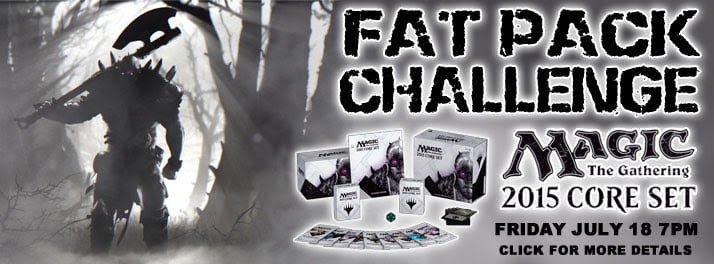
About the author
Simeon is now the Community Manager for Battleground Games & Hobbies. If you have any questions or inquiries, then you can reach him at Sims@battlegroundgames.com. He is also an avid gamer who loves to play board games and video games. He graduated college with a degree in Political Science, and now serves the public by writing about games. You can check that out here. Don’t forget to “like” him on Facebook as well. It’ll update you on all of his newest content. Best of all, you can follow Simeon on Twitter (@SimeonCortezano) for some real time hilarity. Thanks for reading!
Donate to the Extra-Life fundraiser!

About Battleground Games & Hobbies
| |||||
| |||||
Tags: Fat Pack Challenge, Magic the Gathering, MTG, Simeon Cortezano, Wizards of the Coast
Posted in Blog, Card Games, Events, Featured Author, Featured Post, Magic: The Gathering, Popular Posts | No Comments »
This week in Magic: M15 pre-release primer
Thursday, July 10th, 2014
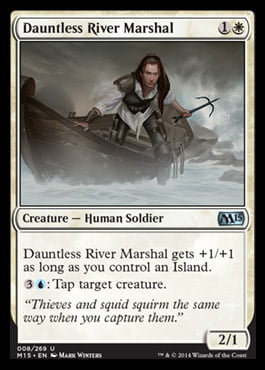
It’s that time of the year again, Magic lovers: another core set is upon us. That mean this weekend, all over the world, local game stores will be hosting pre-release events. Have you studied up on your core set yet? Do you have an idea as to what color you’re going to ask for? Are you confused? It’s okay. That’s what I’m here for. Let me present a little primer you can use heading into this weekend’s pre-release.
There is a lot to go through, so we’re going to go through each color, one by one. Also, a lot of the times, the mythics and rare cards tend to stand out on their own in terms of power. With that in mind, let’s take a look at the commons and uncommons. These are cards that people look over because of their rarity (or lack there of).
I don’t plan on doing a series, so you’re going to get an abridged version of each one. So where should we start? How about with…
White
In Limited formats, creature removal is always on the lighter side of things – meaning that there isn’t much to go around. If you do come across some, your best bet may to run the colors where your removal lies. However, that’s not always the best decision. So keep in mind what your pool, as a whole, has to offer.
So what stands out to me? One card I really like is Oppressive Rays. While it doesn’t get rid of your problems entirely, they do hinder your opponent quite a bit. In fact, sometimes it just isn’t worth it for your opponent to pay mana in order to attack or use a creature’s ability. In that sense, this can be considered creature removal.
Another card that stands out is Pillar of Light. This is a three mana Instant spell that removes a creature with toughness “4 or greater.” This is really interesting because usually cards are worded to have “power” be the leading cause of removal, but in this case, we need to pay attention to the creature’s toughness. This can still be effective in the event that the creature has such a high toughness, it makes attacking difficult.
As far as creatures go, Dauntless River Marshall is a really solid creature. Played in the right colors, he will be one of the best creatures in the format. As long as you have an island in play, he will be a 3/2 for two mana. His ability to tap creatures has always been a really good ability in the past. The added bonus of not having to tap to activate it will prove to be very useful.
Blue
Void Snare is probably in the Top 3 for the entire set in my opinion. I think it’s even good enough to see play in Standard. So what does it do? For one blue mana, you can return target nonland permanent to its owner’s hand. It may be a little slow for some people, but keep in mind this can return Planeswalkers to their owner’s hand.
Another Blue spell I am a big fan of is Encrust. For three mana, we can enchant a creature or artifact. Once enchanted, that permanent does not untap during their controller’s untap step and it’s abilities cannot be used or activated as well. Sounds good to me.
The best Blue creature here s definitely the Jorubai Murk Lurker. Similar to its white counterpart, give that the player is playing the right color combination, it can be a 2/4 for three mana that has the potential to gain its owner life. Sound familiar? Yes, that’s because it sounds just like a Courser of Kruphix.
Black
When Stab Wound made its debut in Return to Ravnica, it was winning games on its own. If a player could stick it onto a creature that was say a 2/3 – making it a 0/1 – that player would not have to attack or rarely play another spell. Once applied, the enchantment would be enough to kill the opponent over time.
Necrobite is another great spell in black. It will definitely be one of those combat tricks that, if you fall victim to, will feel very painful. Here’s a terrible scenario you may not want to be part of. Imagine swinging for the win with a creature your opponent could not possibly kill given what’s on the board. Your opponent goes to block with a tiny 1/1 and with no card in your hand (and nothing to worry about) they cast Necrobite on their creature, thus kill your creature and their’s surviving. Time to break out the tissues.
I really think that the Leeching Sliver is the best creature Black has to offer in the common/uncommon field. The best part is that is only gets better the more slivers you can attack with. Yes, I understand that it’s completely conditional, but it’s worth it in the end. Think about it, then get back to me and let me know what you think about it.
Red
Stoke the Flames is at its best when its caster can convoke any part of its casting cost. Still, to be able to do 4 damage for four mana is pretty good in Limited. There are not many 4 damage spells in the game. However, remember that this spell can only hit a player. Knowing myself, though, I’m sure I will still be pointing it at creature numerous times – even after I’ve been told I can’t by Ken Briscoe.
Lightning Strike and Shrapnel Blast are tied as “next best spell.” You’re probably asking why Shrapnel Blast? I understand you need to sacrifice a creature (and there is a wonderful creature you could sacrifice if you get it within your pool). The chance to do 5 damage to either a creature or a player is huge. As for Lightning Strike, it is as close as we’ll get to a Lightning Bolt until they reprint Lightning Bolt (which should happen any day now).
For creatures, I think the Generator Servant will be the one to look out for. If it doesn’t get killed right away, providing two extra mana the following turn (five mana at the earliest) and its controller could easily cast one of the Souls (cast on turn three, activate on turn four and don’t miss a land drop). The outcome is very fightening.
Green
There are not a lot of non-creature spells I am a fan of. So, instead lets take a look at the creatures. First up is the Sunblade Elf. Out of this entire cycle of creatures, I think this one will definitely see play in Standard. Thanks to lands like Temple Garden and Green/White being a popular deck color combination, having a 2/2 for one mana is like the good ol’ days of playing turn one Savannah Lions. However, in this case, we have a 2/2 rather than a 2/1 which is a huge difference coming off of turn one.
I’ve always been a fan of Wall of Mulch. The only other time it was printed was in Onslaught (which makes me this old). Even then I think it was a solid card. I liked that it was a decent sized wall for only two mana. The best feature about it has to be that you can draw a card with it. This could potentially save your life by blocking something huge, then pay that one green mana and draw yourself a card. Thanks Wall of Mulch for being such good friend!
Finally, Roaring Primadox is one of those creatures, when dropped, can make your opponent cringe. First of all, its a 4/4 for four mana. That alone is really solid. Now, add in the ability to combo with another creature, and the potential can be devastating. Take, for example, Heliod’s Pilgrim. You could potentially fetch up a aura spell every turn. Or imagining bouncing your Tireless Missionaries and casting them again over and over, gaining three life each turn. Talk about back breaking.
Well that’s it for now. I hope you found this enjoyable and helpful. After you get back from your pre-release event, come back here and let us know what your experience was like and what awesome cards (or combinations) you got to play. Have fun this weekend.
About the author
Simeon is now the Community Manager for Battleground Games & Hobbies. If you have any questions or inquiries, then you can reach him at Sims@battlegroundgames.com. He is also an avid gamer who loves to play board games and video games. He graduated college with a degree in Political Science, and now serves the public by writing about games. You can check that out here. Don’t forget to “like” him on Facebook as well. It’ll update you on all of his newest content. Best of all, you can follow Simeon on Twitter (@SimeonCortezano) for some real time hilarity. Thanks for reading!
Donate to the Extra-Life fundraiser!

Join the Battleground Games & Hobbies community forums!
Please don’t forget to check us out on Facebook and follow us on Twitter @battleground_gh!
Tags: core set, Magic the Gathering, MTG, Pre-release, Simeon Cortezano, Wizards of the Coast
Posted in Blog, Card Games, Events, Featured Author, Featured Post, Magic: The Gathering, Popular Posts, Store Related | No Comments »
This week in Magic: Playing with fire pt. 2
Thursday, July 3rd, 2014
Last week we talked about the burn package for Mono Red Burn. This week I’ll be talking about the creature package and side board options. Here’s a quick reminder of what I was running as a creature package:
This past weekend, there was a Grand Prix Trial held at the Abington store. At that tournament I actually ran a slightly different creature package after having practiced with the deck some more. The changes I made were replacing the Hellspark Elemental completely and I put in two more Goblin Guides and two more Eidolons. So now I was playing with this:
4 Goblin Guide
4 Eidolon of the Great Revel
4 Spark Elemental
I have been really enjoying the Eidolons a lot. If my opponent can’t deal with it right away it can be really annoying as it hits a lot of spells. This includes, but isn’t limited to, Serum Visions, Remand, Tarmogoyf, Delver of Secrets, Dark Confidant, and so much more. Even if they can deal with it, they’re going to take two damage as the popular removal spells are Disfigure, Smother, Lightning Bolt, Electrolyze, etc. There are definitely a lot of pros to playing this card.
One slight downside is that I am not immune to its effects as I can also take two damage for any spell I play that costs less than three mana. However, I’m not worried about my life count as much as my opponent is when he knows I’m threatening him or her with numerous burn spells at the ready.
I guess the question is how do I feel about the new creature line-up? When I played at the GPT, part of me did miss the Hellspark Elemental. With the Eidolon I get a 2/2 for two mana, and it doesn’t usually stick around. With the Hellspark, I got a 3/1 hasty creature that usually got in for three damage. The reason being is that it dies at the end of the turn. Therefore, wasting a kill spell on it is almost meaningless.
You really want to get in there and drop your opponent’s life total down to zero as fast as you can. If you remember, last week, I preached about how we were going for maximum damage output. Well, Eidolon doesn’t fit that game plan. It’s something you’d want if you were shooting for a long-game scenario – something that we’re not aiming for. We want to go for the short-game, and so it’s time to go back to four Hellspark Elementals and take out the Eidolons completely. Everything else can stay the same. In fact, going up to four Goblin Guides is where we should have been from the beginning.
Side board options
Now let’s take a look at the side board. As a quick reminder, here is what I was running:
3 Combust
This did not change at all for the GPT last weekend. Still, let’s break things down and talk about why I’m running them.
First of all, Combust is a card that I have to run. Granted it doesn’t hit our opponent directly, but it does solve a lot of problems for Red mages. One of the biggest targets is Deceiver Exarch. Sitting at 1/4, this creature has a big butt, and is out of reach for all of our burn spells. Instead of having to use two burn spells, we can cast Combust, and that’s not even the best part: it can’t be countered. Other targets for Combust include Archangel of Thune, Restoration Angel, and anything else that’s blue or white and really annoying.
I originally thought that Molten Rain was one of those cards just for Tron decks. However, Modern has plenty of three colored decks where mana is a sensitive issue – RUG Twin, some versions of Pod, and Jund to name a few. In some of my play test sessions, destroying a land only set my opponent back a turn, but sometimes that’s all you need. Did I also mention that it also deals two damage as long as that land is a non-basic land.
Relic of Progenitus is in there for Snapcaster decks, decks that centralize themselves around Tarmogoyf, and can be a cute trick against Pod decks. It’s a pretty situational card, that’s why you only need two.
There have been plenty of discussions for the next card and the slot it represents. Affinity is one of the most popular decks in the Modern format right now. However, you need to remember not everyone is playing Affinity and that Modern is a very diverse format. So, you need a card that can match up well against Affinity, but can also help you out against single, problem artifacts – the biggest problem child, of course, being Spellskite.
In the very first list I was running, I had Smash to Smithereens in my side. This was a solid card. It was an instant speed, artifact removal spell, and it did three damage to my opponent. What a great 2-for-1. Unfortunately, in the match-up against Affinity, I couldn’t handle the amount of pressure they put on you in the first few turns. I watched as some of my friends emptied their hands on their first turn at the GPT.
With Shattering Spree, I feel like I have a better handle on things. It may not solve all of my problems, but it will definitely solve some of them. It’s ability to Replicate itself is a big deal. Now I can feel comfortable bringing in this card against decks with only a few artifacts or Affinity. I lose ability to deal three damage and I lose the speed, but being able to hit multiple artifacts is huge for me.
Searing Blood has been doing a lot for me these past few weeks. It’s been doing so much, I’ve had considerations bringing it into the main roster and, even, replacing Searing Blaze with it. Now, before you jump on my case, hear me out.
First of all, it’s in the sideboard as added creature removal. I bring it in against Affinity, Zoo, Pod, and even Delver. It played a pretty clutch role for me in my first round of the GPT. In game three, my opponent played a turn one Birds of Paradise. I didn’t even hesitate and cast a Searing Blood on it. I ended up winning that game and the match. Afterwards, he told me that if I hadn’t destroyed the Birds, he would have been able to play an earlier Birthing Pod against me, and probably would have won the game.
Now, I know what you’re saying, “You could have done that with Searing Blaze as well.” I know that, but here’s why I want to play it in the main board. I don’t play any fetch lands. This is important because triggering the landfall ability on Searing Blaze becomes much harder to do. In a deck that only runs 20 lands, it’s a little tough. Not to mention, I can only Blaze on my turn.
Last, but not least, is Anger of the Gods. I’m actually still debating with myself if I want to keep this or run Volcanic Fallout. Fallout is really tempting because it can’t be countered. So it would stack up well against decks like Faeries and Merfolk – both of which I have encountered. Either way, both spells would do well against Affinity as well. Maybe the extra point of damage matters, but that’s if they manage to drop their Master of Etherium. Another reason to run Anger over Fallout is that it exiles creatures if they were to die. So, against Pod decks, where Kitchen Finks is a thing, it could be very useful to remove the creature instead of letting it hit the graveyard and come back.
Well, that’s it for this week as I destroy my word count once again. I hope you’ll come back next week as I look to conclude my discussion on Mono Red Burn for Modern. The GP is coming up at the end of the month and this is really helping me clear my mind about things.
I would appreciate any feedback you may have or criticism about the deck. So sound off below in the comment section.
About the author
Simeon is now the Community Manager for Battleground Games & Hobbies. If you have any questions or inquiries, then you can reach him at Sims@battlegroundgames.com. He is also an avid gamer who loves to play board games and video games. He graduated college with a degree in Political Science, and now serves the public by writing about games. You can check that out here. Don’t forget to “like” him on Facebook as well. It’ll update you on all of his newest content. Best of all, you can follow Simeon on Twitter (@SimeonCortezano) for some real time hilarity. Thanks for reading!
Donate to the Extra-Life fundraiser!

Join the Battleground Games & Hobbies community forums!
Please don’t forget to check us out on Facebook and follow us on Twitter @battleground_gh!
Tags: Grand Prix Worcester 2014, Magic the Gathering, MTG, Simeon Cortezano, Wizards of the Coast
Posted in Blog, Card Games, Featured Author, Featured Post, Magic: The Gathering, Popular Posts | 2 Comments »
This week in Magic: Playing with Fire
Thursday, June 26th, 2014
First there was Tom Ross taking down the SCG Invitational with his Boss Sligh deck. Then this past weekend, both the Standard and Legacy Opens by StarCityGames were taken down by Red decks. One was a Mono Red Aggro deck and the other was a Mono Red Burn deck. I guess it’s safe to say that Red is a thing now.
With that in mind, I’m going to talk about Mono Red Burn in Modern. Keep in mind, I want to stay one color because for consistency. If we start introducing another color, then we have to start thinking about Shock Lands and Fetches. I’m trying to Bolt you, not the other way around.
Before we delve into things, let’s take a look at what I’ve been running for a while now:
Main board:
20 Mountain
Side board:
3 Combust
Goal of the deck
What exactly are we trying to do with this deck? Well, it’s simple. Have you ever seen “Rocky Balboa,” you know, the last movie he did that came out in 2006? Well in that movie there is a great training montage (just like all the other movies before it). During that montage they address the fact that Rocky has gotten older and suffers from things like arthritis; the fact is that he’s just not his younger self anymore. So, his trainer comes up with a strategy to compensate for what he has lost.
“So what we’ll be calling on is good ol’ blunt, force trauma. Horse power. Heavy-duty, cast iron, pile driving punches that will have to hurt so much they’ll rattle his ancestors. Every time you hit him with a shot, it’s got to feel like he’s kissing the express train. Yeah. Let’s start building some hurting bombs.”
Cue the music.
This is one of the best lines in the movie. When I saw it, and heard that line, I wanted to work out right then and there. Unfortunately, the tub of popcorn and the soda I was drinking were in my way.
I’m not trying to say that Mono Red Burn is like an old man, but it does have its weaknesses. The key here is to explode. This theme is going to help what determines what spells we should and should not play.
Another way to look at things is to check out some solid reading called “The Philosophy of Fire,” by Mike Flores. Just do a quick search for it online. You can’t miss it.
The Burn
We want to apply maximum damage for as little as possible. Lightning Bolt is the best burn spell and is a great example to base everything off of. It deals three damage for one mana. It hardly gets better than that. The next best thing may be Shard Volley. This is another spell that can deal three damage for one mana, but it comes with a catch; you need to sacrifice a land as an additional cost. That means, whether it resolves or not, you’re still losing a land.
Lava Spike is a great contender as to “next best burn spell.” It’s another 3-for-1 spell, but we lose out in speed here. Still, as a sorcery, this is typically one of the best openers for this deck. Similarly, Rift Bolt does the same thing. There is a slight delay if, but rarely do you ever cast it for three mana.
Now we move onto the spells that cost more than one mana. Searing Blaze is an interesting card, but it definitely has value in it. It’s very conditional, and it doesn’t always hit for three damage. In fact, by itself, it does one damage for two mana. Plus, you need to have a creature in play on your opponent’s side. So why is this in the deck? When you do hit the landfall trigger, which is not that hard, the card becomes completely worth it. At instant speed, you can, potentially, hit your opponent for three damage and kill one of their creatures for two mana.
How do we perceive Searing Blaze, though? It’s a 2-for-1 for starters. What else though? We need to analyze the other spells fit into the two slot:
Arc Trail – Needs another player to target.
Boros Charm – It forces us to play another color. However, because it deals 4 damage, many people have felt that’s enough of a case to play the spell. Keep it in mind, it only deals damage to a player.
Incinerate – Three damage for two mana makes it a contender, but there are better spells for the slot.
Lash Out – Another possibility, but conditional upon the clash.
Lightning Helix – The ability to gain life and, essentially, cause a six point life swing is very nice. However, again, you need to introduce another color into the mix.
Lightning Strike – See Incinerate.
Magma Jet – In the other versions of the deck that was touched upon at the beginning of the article, Magma Jet has made the cut. The ability to scry two cards and manipulate the deck so you draw into burn is very convincing. We’re looking for more here. If I’m scrying in search of burn, I’ve already lost.
As you can see, there are options, but we’re Mono Red. Searing Blaze just beats out the competition by a hair. There is another spell in the two slot. That card is Skullcrack. This is very similar to Lightning Strike and Incinerate. However, there is an important part of the card that causes it to make the cut, and that’s the fact that it stops players from gaining life and damage cannot be prevented that turn.
Granted, some decks only play one, but Spinx’s Revelation is in Modern. There is also Kitchen Finks. Modern can be a fast format, and there is little room for mistakes. Any kind of life gain is such a set-back that its best to not take any chances. Did you know that Pod decks can gain infinite life? Yes, and I learned that the hard way over the weekend. Thank goodness I had a Skullcrack in hand to stop the shenanigans.
Finally, our last spot is for Flames of the Bloodhand. This is the most expensive burn spell in the deck, but it’s also our only spell that does four damage. It hits like an express train and stops life-gain and, once again, stops damage prevention.
That’s it for this week as I go well over my word count. Next week, we’ll pick things up and go over the creature package, the side board, and any changes I may want to make heading into Grand Prix Worcester.
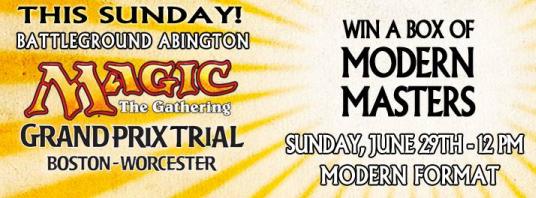
About the author
Simeon is now the Community Manager for Battleground Games & Hobbies. He is also an avid gamer who loves to play board games and video games. He graduated college with a degree in Political Science, and now serves the public by writing about games. You can check that out here. Don’t forget to “like” him on Facebook as well. It’ll update you on all of his newest content. Best of all, you can follow Simeon on Twitter (@SimeonCortezano) for some real time hilarity. Thanks for reading!
Donate to the Extra-Life fundraiser!

Join the Battleground Games & Hobbies community forums!
Please don’t forget to check us out on Facebook and follow us on Twitter @battleground_gh!
Tags: Magic the Gathering, Modern, MTG, Simeon Cortezano, Wizards of the Coast
Posted in Blog, Card Games, Featured Author, Featured Post, Magic: The Gathering, Popular Posts | 2 Comments »
- Products
- Buylist
- Policies
- Contact Us







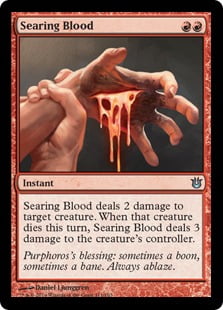

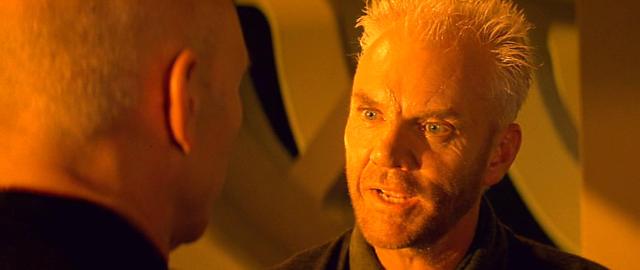


Social: